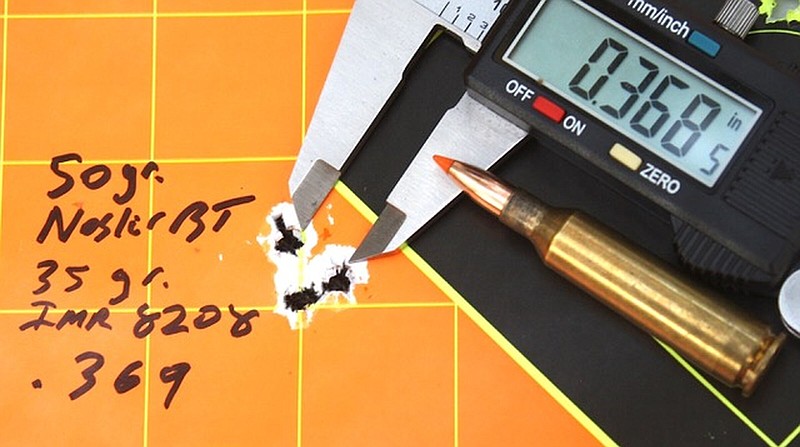Reloading centerfire ammunition is a great way to spend the late days of winter.
Although factory ammunition is satisfactory, reloading your own cartridges gives you absolute control over every component in your ammo. You can tailor your loads with your preferred bullets, primers and powders. Best of all, you can tailor your loads to suit an individual rifle or pistol.
Match shooters reload to ensure precise consistency. For them, it's a laborious process that requires eliminating all radical variables. Match shooters require every bullet and every empty brass cartridge to be the exact same weight. They also buy primers in bulk from the same lot to eliminate variances between lots.
Many do it to tailor a load for a particular firearm that combines the magic balance of velocity and accuracy. Others do it merely to see how much powder they can pack into a cartridge before brass starts to fail. Some reload because it is the only way to use the premium bullets they like.
As with any hobby, you can enter with any level of investment you desire. You can buy kits from RCBS, Hornady, Lee and Lyman that come with almost everything you need to load metallic cartridges. Included is a single-stage press, a balance beam scale, powder measure, funnel, shell block, primer pocket brush, case lubricant and reloading manual. An all-inclusive kit costs about $500.
You must buy specific dies for the cartridge or cartridges you want to reload. I began my reloading journey using RCBS dies and converted to Lee Precision dies with excellent results. To reload 6.5 Creedmoor cartridges I use Redding dies. The quality of Redding dies is conspicuously superior to the others.
Preparaing cases requires a chamfering and deburring tool, and a set of calipers to measure your case length and overall cartridge length after you seat the bullet. You also need a case trimming tool to shorten cases that stretch beyond spec after repeated reloadings.
For considerably less money you can buy a Lee Loader. They are available for most popular cartridges on ebay from $20-$100. The Lee Loader is an all-in-one item that allows you to deprime, reprime and resize your cartridge necks, load powder and seat the bullet. The entire unit fits in the palm of your hand and occupies a box that is only 6 inches long and 3 3/4 inches wide. Of course, you still need a scale, calipers and chamfering and deburring tool, and ultimately a case trimmer when your cases stretch beyond spec.
A load starts with a bullet. A good deer hunting weight for a 30-06 is 150- or 165-grain. For 30-06, start with a 150-gr. Nosler Ballistic Tip. That page in the Nosler Reloading Manual has 10 powder choices with minimum, maximum and mid-range powder charges. It also specifies a particular primer. Do not start with a maximum charge.
First, lightly lubricate the first of every five cartridges. The first cartridge will lightly lubricate the inside of your full-length resizing die. If too much lube accumulates inside a die, it will dent your case.
Following the directions included with your dies, screw the full-length resizing die into your press. Pull down the press handle to ram the cartridge into the die. This will resize the entire case and eject the spent primer.
Chamber that freshly resized case into your rifle. It should chamber with minimal resistance, and the bolt should close smoothly.
If the bolt won't close or if it closes with much resistance, adjust your die downward very, very slightly. This will adjust the neck angle until it fits your rifle's throat. Continue to resize the die until it chambers smoothly.
With your case properly resized, prep your case by chamfering and deburring the case mouth. Also scrub out the primer pocket. You can do this with the chamfering and deburring tool, and also the primer pocket brush that came with your kit. You can also buy a machine that eliminates the hand stress endemic to the hand tools.
Having prepped the cases, install new primers with a primer installation tool or with an attachment that comes with your reloading kit. I prefer the external handheld tool.
With the primers installed, load the cases with powder. Minimum and maximum charge weights for the most efficient powders for each cartridge are listed in reloading manuals published by bullet makers and powder makers. This requires weighing powder charges on a scale. I weigh every charge twice. I weigh the first charge on a digital scale and verify it on a balance beam scale.
I load three cartridges with a mid-range charge and work my way up toward the maximum, increasing charge weights by three-tenths of a grain.
Three shots is enough to tell you if a particular bullet/charge combination will group. If you don't like the results, use a different powder or try a different style bullet or primer.
If you reload cartridges fired in the same rifle, they will already conform to your rifle's chamber. If you don't intend to shoot reloaded cartridges in a different rifle, you only need to resize the cartridge neck. You can do this with a Lee Loader or with a neck sizing die.
The last step is to seat the bullet. Adjust your seater die so that your bullet seats with the tip at the maximum overall cartridge length. As your skills progress, you likely will experiment with bullet seating lengths, but maximum cartridge overall length is a good starting point.
Finally, I crimp my bullets into the neck with a Lee Factory Crimp Die. I have noticed from reloading thousands of cartridges that neck tension is highly variable. Crimping eliminates that variable by ensuring uniform neck tension. More meticulous reloaders do it by manipulating the necks into uniform concentricity with various tools like die bushings.
That's a lot of work, but it's worth the satisfaction you get from taking game or shooting tight groups with cartridges you loaded yourself.
